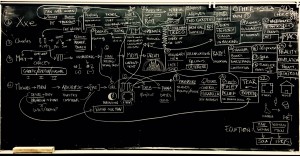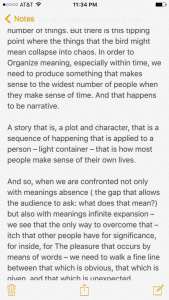The Modern Turn (Away & Toward)
Situating Woolf’s Aesthetics in the History of Literature
Benjamin Boyce
In The Rise of the Novel[1], Ian Watts concentrates on the early British novel, and ascribes a variety of social, political, and religious factors as leading to the novels development. A quick summary of these forces would include, a rising middle class (literate and with some amount of free time), Puritanism (which put the onus of spiritual growth upon the individual, allowing for a profusion of personal interpretations of the public sacred text), and capitalism (which followed this spiritual accounting with a material accounting—an exactness that I think gave Britain the edge over other civilizations and propelled it into a world power).
After the novel caught on, it went through certain developments. In the early 18th century the novel was often introduced by an argument by the author as to the “authenticity” of the document—that it was taken from a real man’s or woman’s journals or letters. (Robinson Crusoe by Defoe, and Richardson’s Pamela). But these apologetics were abandoned as the reading public became used to thinking in the way that the novel was thinking—that is, the presentation of fictional events and persons that more or less matched up with common people’s common experience. This was in contradistinction to the Medieval Romance, which presented heroes and scrubs undergoing repetitive events that provided opportunities for triumph (for the heroes) and downfall (for the scrubs). In the novel, the sense of a real person undergoing some form of personal development was conveyed.
Soon enough the novel developed into a romantic period, where the efficacy of the events and the characters were not as realistic, or, rather, their dramatic, thematic, and cinematic qualities were “turned up” to render heightened states of experience. About midway through the romantic period, in France the idea of realism took root, where authors returned with a renewed gusto to describing as clearly as possible the real world, how people really thought and experienced things.
I believe that Woolf’s work is in part a response to realism, which, in her essay Modern Fiction[2] she calls “materialism”, about which she writes:
The writer seems constrained, not by his own free will but by some powerful and unscrupulous tyrant who has him in thrall, to provide a plot, to provide comedy, tragedy, love interest, and an air of probability embalming the whole so impeccable that if all this figures were to come to life they would find themselves dressed down to the last button of their coats in the fashion of the hour. They tyrant is obeyed; the novel is done to a turn. But sometimes, more and more often as time goes by, we suspect a momentary doubt, a spasm of rebellion, as the pages fill themselves in the customary way. Is life like this? Must novels be like this?
Now, if she is reacting against this materialism, this tyranny of the supposedly real, what is she aiming toward? Woolf argues that, if novels are about life, then the issue is if life is true to realism, if realism is true to life.
Life is not a series of gig lamps[3] symmetrically arranged; life is a luminous halo, a semi-transparent envelope surrounding us from the beginning of consciousness to the end. Is it not the task of the novelist to convey this varying, this unknown and uncircumscribed spirit, whatever aberration of complexity it may display, with as little mixture of the alien and external as possible? We are not pleading merely for courage and sincerity; we are suggesting that the proper stuff of fiction is a little other than custom would have us believe it.
She then speaks of Joyce, and about reading Ulysses:
In contrast with those whom we have called materialists, Mr. Joyce is spiritual; he is concerned at all costs to reveal the flickers of that innermost flame which flashes its messages through the brain, and in order to preserve it he disregards with complete courage whatever seems to him adventitious, whether it be probability, or coherence, or any other of these signposts which for generations have served to support the imagination of a reader when called upon to imagine what he can neither touch nor see.
Woolf then goes on to very indirectly criticize Joyce and his methods. Writing that while Ulysses is brilliant, it gives us the sense that we are constrained in the author’s head, to a sense of
…being in a bright yet narrow room, confined and shut in, rather than enlarged and set free, to some limitation imposed by the method as well as by the mind. Is it due to the method that we feel neither jovial nor magnanimous, but centered in a self which, in spite of its tremor of susceptibility, never embraces or creates what is outside itself and beyond? Does the emphasis laid, perhaps didactically, upon indecency, contribute to the effect of something angular and isolated?
In our reading of Mrs. Dalloway we might have seen how a multiple points in the novel, Woolf uses “angularity” in reference to men.
I would like to propose that what Woolf found lacking in Joyce was something that she might of thought of as a masculine preoccupation with form, whereas she was more concerned with the halo, the “frequency” of consciousness, which is not situated in forms or formality, but that drifts atop them, variates them, organizes them with a deftness and arbitrarity that is itself the form of consciousness—not formless but over, between, around—a movement, a “halo.” In Mrs. Dalloway, she uses the form of a single day-in-the-life (perhaps following Ulysses), but whereas Ulysses is filled with method, with symbols, and themes subdivided and subdivided into smaller and smaller symbolic units which Joyce then fills with consciousness, Mrs. Dalloway only uses as much form as is necessary for Woolf to enter into the profusion of consciousness, to convey that consciousness in a manner that the reader can follow and can reconstruct in their own imaginations.
In Modern Fiction she writes:
The problem before the novelist at present, as we suppose it to have been in the past, is to contrive means of being free to set down what he chooses. He has to have the courage to say that what interests him is no longer ‘this’ but ‘that’: out of ‘that’ alone must he construct his work. For the moderns ‘that’, the point of interest, lies very likely in the dark places of psychology.
I wonder if, at this point in the history of the arts, we can afford to be for ‘this’ as opposed to ‘that’ or that as opposed to ‘this.’ What we have to always account for is that there is already so much art out there, there are already so many artists out there. We might seek to build monuments, such as did Joyce, or seek to give the imaginal sea as minimal a form as possible, in order to study and to immerse ourselves and be swept along with its flow, as did Woolf—especially in The Waves, written after Mrs. Dalloway. We have to be concerned with getting attention and keeping attention, while at the same time trying to trick our readership into a deep and lasting experience of something profound—profound even in its pettiness, in its birdlike chatterliness or angular indecency.
[1] The Rise of the Novel; Studies in Defoe, Richardson, and Fielding. Berkeley: U of California, 1957. Print.
[2]http://www.massey.ac.nz/massey/fms/Colleges/College%20of%20Humanities%20and%20Social%20Sciences/EMS/Readings/139.105/Additional/Modern%20Fiction%20-%20Virginia%20Woolf.pdf
[3] A gig lamp is the headlamp of the horse-and-buggy generation.


